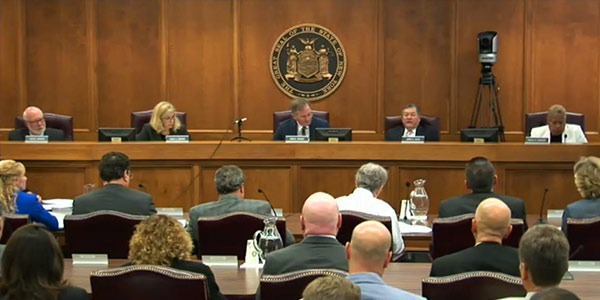By Michael Kuser
New York regulators on Thursday kicked off a proceeding to examine how to reconcile NYISO’s resource adequacy (RA) programs with the state’s renewable energy and carbon emission-reduction goals (Case 19-E-0530).
“This item to open an inquiry is important and timely,” Public Service Commission Chair John B. Rhodes said. “We at the commission have a duty to ensure safe and adequate power. Safe means safe, and adequate means, in this case, [that] there’s power when New Yorkers need it. … It’s becoming questionable whether the answers that were organized at least 20 years ago are in fact the best answers for the situation we face today.”
David Drexler, the PSC’s managing attorney, said “a major impetus” for the RA inquiry is New York’s recently passed Climate Leadership and Community Protection Act (A8429) — particularly its mandate that 70% of the state’s electricity be generated by renewable resources by 2030.
Commissioner Diane Burman said she understood the need to examine electricity issues, “but I do find it disingenuous to say that we have an obligation to do this when there are many other issues that we have an obligation to examine,” pointing to Consolidated Edison’s moratorium on providing new customers with natural gas hookups in Westchester County until it can ensure adequate supply to the region.
“I think the chairman nailed it when he said that the current approach was set 15 to 20 years ago, and it’s based on the cost attributes of a fossil generator,” said Warren Myers, director of regulatory and market economics for the state’s Department of Public Service.
The inquiry will focus on answering several questions, including:
- Are the state’s energy policies and mandates, such as those related to offshore wind, photovoltaics, other renewables and energy storage, compatible with NYISO’s RA mechanisms? If not, what issues are manifested? Also, if not, how could they be aligned? Do policies and market structure mechanisms result in safe, adequate service at just and reasonable rates?
- Is an installed capacity (ICAP) product an effective long-term solution for RA given the required future generating resource mix, which may have lower marginal costs or different availability profiles than many current generation resources in operation? What are the salient attributes of such long-term solutions?
- Is there a preferred mechanism for ensuring RA? What are the cost impacts and benefits to consumers under the various potential RA mechanisms?
- Should alternative approaches be considered to ensure that procurement of generation resources is aligned with state policy goals? If so, which ones? Are there existing or proposed models that might be instructive, such as the state overseeing the RA portfolios of load-serving entities as in California, or should NYISO rules be restructured to accommodate state policies?
- What is the state’s role with respect to RA matters?
- What, if any, next steps should the commission take with respect to RA matters?
First of Many

Burman said she would ask the “elephant-in-the-room question,” wanting to clarify that the PSC’s new effort would not seek to “undo the role of the ISO” regarding RA, “but in fact is looking at how can we work on these issues.”
“The elephant is prematurely in the room,” Myers responded.
Drexler said, “Actually, from a staff perspective, we’re not prejudging any of the issues at this point. This is merely meant to start the inquiry.”
Commissioner James Alesi supported the inquiry, saying that “New York is already on its way to cleaner energy consumption.”
Commissioner Tracey Edwards said it was better to start asking the right questions now than later, “when we’d be doing so in a defensive posture.”
Attending his first session since being appointed to the PSC on July 19, Commissioner John Howard said, “The truth is, the ISO and its markets work today; the lights stay on; people get paid. If you’re an incumbent, things seem to be pretty well-ensconced. However, that doesn’t mean there aren’t holes that need to be examined. … I believe this will be the first of many inquiries.”
In an Aug. 8 blog post, Jackson Morris and Cullen Howe of the Natural Resources Defense Council welcomed the PSC’s inquiry and raised two points.
“A central concern held by many stakeholders, including NRDC, is that NYISO’s capacity market rules could prevent clean energy resources supported by state and local policies from selling in that market, thereby depriving these resources of an essential source of revenue. …
“Another concern is that NYISO’s rules undercount the value of cleaner resources like energy storage systems, as well as wind and solar, while over-crediting highly polluting power plants.”
Burman expressed additional concern that the proceeding seems to lack direction: “Ultimately, all we seem to be addressing is the capacity markets and buyer-side mitigation, and then taking a look at, in some fashion, whether or not we want to change those rules.”
The commission has asked interested parties to submit initial comments by Nov. 8. Commenters can file with the DPS by e-filing or by email to secretary@dps.ny.gov, or through the department’s Document and Matter Management System.
“Today’s order is the beginning of an important discussion on resource adequacy, and we look forward to engaging with the Public Service Commission throughout the process to share our expertise, information and ideas,” NYISO CEO Rich Dewey said in a statement.







